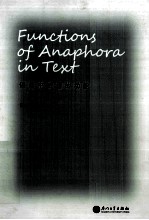

语篇中回指的功能PDF电子书下载
- 电子书积分:11 积分如何计算积分?
- 作 者:梁鲁晋著
- 出 版 社:厦门:厦门大学出版社
- 出版年份:2008
- ISBN:9787561530382
- 页数:280 页
Chapter 1 Introduction 1
1.1 The aim of this book 1
1.2 The nature of anaphora 2
1.3 Research questions 6
1.4 Methodology 7
1.5 Organization 8
Chapter 2 Literature Review 11
2.1 A brief history of anaphora study 11
2.2 Contemporary approaches to anaphora 18
2.3 Summary 42
Chapter 3 Theoretical Foundations for Anaphora Study 44
3.1 Construal of anaphora within the functional framework 44
3.2 Remaining problems 59
3.3 A proposed framework for anaphora 62
3.4 Summary 76
Chapter 4 Textual Function of Anaphora 79
4.1 The lexical level 80
4.2 The grammatical level 91
4.3 The semantic level 99
4.4 The textual level 113
4.5 Summary 137
Chapter 5 Interpersonal Function of Anaphora 142
5.1 Understanding the interpersonal function of anaphora 143
5.2 The writer-society relationship 147
5.3 The writer-reader relationship 158
5.4 Summary 163
Chapter 6 Cognitive Function of Anaphora 165
6.1 Frame-based integration 165
6.2 Context-constrained inference 184
6.3 Memory-related retrieval 198
6.4 Summary 211
Chapter 7 Anaphora in Application 214
7.1 Testifying method 214
7.2 Anaphora in text 218
7.3 Summary 231
Chapter 8 Conclusion 233
8.1 Reflection on the research questions 233
8.2 Implications of this research 238
8.3 Limitations in anaphora study 240
Bibliography 242
Appendix Ⅰ:Three Texts for Sample Analysis 259
Appendix Ⅱ:Findings of the Three Sample Texts 276
Acknowledgements 280
List of Figures 16
Figure 2-1 Bühler's Organon-Model of Communication(after Bosch,1983:10,and Bühler 1934) 16
Figure 2-2 Connection between historical views and contemporary approaches to anaphora 17
Figure 2-3 The c-command diagram(adapted from Radford,1988:119) 20
Figure 3-1 The place of anaphora within the semantic system in SFG framework(taken from Halliday&Hasan,1976:29) 51
Figure 3-2 The place of anaphora within the system of reference(reproduced from Halliday&Hasan,1976:33) 51
Figure 3-3 The place of anaphora in the realization relationship between the situational system and the semantic system(reproduced from Halliday,1985:2) 55
Figure 3-4 The place of anaphora in the instantiation relationship(reproduced from Halliday&Matthiessen,1999:14) 56
Figure 3-5 The functions of anaphora in text 74
Figure 4-1 First and subsequent mention of participants in Example(12)(after Martin,1992:94) 84
Figure 4-2 Clausal process types and subjectobject positions of the anaphors as participants in Example(17) 94
Figure 4-3 The bi-dimensional characteristic of anaphora in Example(12) 100
Figure 4-4 Ontological and linguistic reference of the anaphor"he"in Example(12) 104
Figure 4-5 Anaphoric continuity and topical continuity in Example(25) 119
Figure 4-6 Cohesive chains in Example(27) 129
Figure 4-7 Interaction between the topic chain of"she"and the non-topic strings in Example(27) 134
Figure 5-1 The role of anaphora in the two types of interpersonal relationship 146
Figure 5-2 Notions related to reference point(taken from Langacker,1996:356) 152
Figure 5-3 The switch of reference point in Example(30) 153
Figure 5-4 Attribution through antecedent embedment 156
Figure 5-5 Antecedent embedment in Example(31) 156
Figure 5-6 Non-attribution through antecedent-anaphora pattern 157
Figure 5-7 The antecedent-anaphora pattern in Example(29) 158
Figure 6-1 The simple spatial framework of a truck 183
Figure 6-2 Bridging anaphors within the spatial framework of a"truck"in Example(38) 183
Figure 6-3 Two mapping relationships in the blend metaphorical anaphors 197
Figure 6-4 The evoked senses of"home" 211
Figure 7-1 Topicality establishment according to the frequency of anaphora of certain antecedents(measured against percentage;frequency:per one thousand words) 220
Figure 7-2 Topicality-constrained anaphora types of major topical entities(measured against percentage;frequency:per one thousand words) 222
Figure 7-3 Proportion of ba type to the other three anaphora types in three sample texts(measured against percentage;frequency:per one hundred anaphora types) 223
Figure 7-4 Antecedents in three sample texts(measured against percentage;frequeney:per 1000 words) 228
List of Tables 131
Table 4-1 Process types,their meanings and key participants(reproduced from Halliday,1985:143) 131
Table 4-2 Process types,their meanings and key participants of the topic chain of"she"in Example(27) 132
Table 4-3 The anaphoric nominal groups with the possessive determiner"her"and the relationships expressed by it 133
Table 7-1 Topicality establishment according to the frequency of anaphora of certain antecedents(measured against number) 219
Table 7-2 Distribution of ba type as compared with the distribution of other anaphora types(measured against number) 223
- 《功能涂料》刘仁主编 2018
- 《海洋功能食品》王卉 2019
- 《功能食品 第2版》孟宪军 2017
- 《汉语韵律的多维特征及其认知功能》吴洁敏,朱宏达著 2019
- 《基于聚合物的多功能纳米复合材料》宋克男,刘春太,(美)郭占虎主编 2019
- 《姜黄素 功能制备及应用研究》马自超,陈文田,李海霞著 2020
- 《肠道健康与功能性食品》侯俊财 2019
- 《功能性纺织产品功能性评价及检测》党敏主编 2019
- 《英汉小说语篇中话语标记功能的对比研究》徐星,张媛著 2019
- 《功能性粮油食品》张金诚,白满英主编 2019
- 《白族大本曲非物质文化遗产建档保护研究》王晋著 2019
- 《鹊华秋色 赵孟俯的生平与画艺》李铸晋著 2019
- 《大学生慕课学习意愿的影响因素与形成机制研究》赵晋著 2019
- 《一个称作单位的学校 基于对晋东M中学的实地调研》王晋著 2012
- 《毛泽东的诗人风采》陈晋著 2014
- 《合并控制法 以美国和欧盟为视角》黄晋著 2013
- 《毛泽东文艺生涯 下》陈晋著 2014
- 《藉酒装疯》张晋著 2000
- 《平台竞争战略》徐晋著 2013
- 《独领风骚 毛泽东心路解读》陈晋著 2013
- 《大学计算机实验指导及习题解答》曹成志,宋长龙 2019
- 《大学生心理健康与人生发展》王琳责任编辑;(中国)肖宇 2019
- 《大学英语四级考试全真试题 标准模拟 四级》汪开虎主编 2012
- 《大学英语教学的跨文化交际视角研究与创新发展》许丽云,刘枫,尚利明著 2020
- 《复旦大学新闻学院教授学术丛书 新闻实务随想录》刘海贵 2019
- 《大学英语综合教程 1》王佃春,骆敏主编 2015
- 《大学物理简明教程 下 第2版》施卫主编 2020
- 《大学化学实验》李爱勤,侯学会主编 2016
- 《中国十大出版家》王震,贺越明著 1991
- 《近代民营出版机构的英语函授教育 以“商务、中华、开明”函授学校为个案 1915年-1946年版》丁伟 2017
